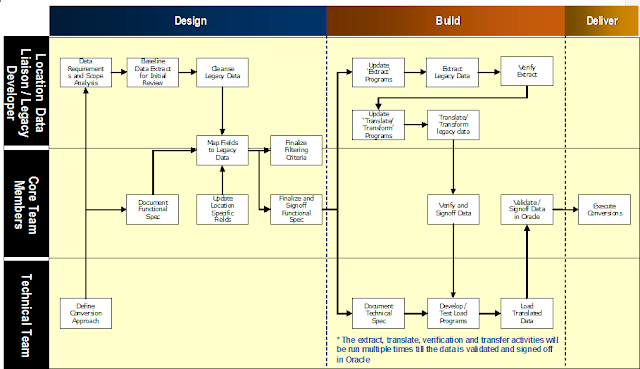Following is the query which details all the purchase orders approved by particular approver for a given date range:-
Parameters: P_START_DATE -- PO Creation Date
P_END_DATE -- PO Creation Date
P_EMP_NUM -- Approver Employee Number
SELECT ph.segment1 po_number, poah1.object_sub_type_code po_type,
pv.segment1 supplier_number, pv.vendor_name supplier_name,
pl.po_amount, ph.currency_code, poah1.action_date approved_date,
poah1.employee_name approver_name,
ppf.employee_number appr_emp_number,
(SELECT ppf1.full_name
FROM po_action_history poa1,
per_all_people_f ppf1
WHERE TRUNC (SYSDATE) BETWEEN TRUNC (ppf1.effective_start_date)
AND TRUNC (ppf1.effective_end_date)
AND ppf1.person_id = poa1.employee_id
AND poa1.action_code = 'SUBMIT'
AND poa1.object_type_code = 'PO'
AND poa1.object_id = poah1.object_id
AND poa1.object_type_code = poah1.object_type_code
AND poa1.sequence_num =
(SELECT MIN (sequence_num)
FROM po_action_history
WHERE object_type_code = poa1.object_type_code
AND object_id = poa1.object_id)) po_submitted_by,
poah1.sequence_num
FROM po_headers_all ph,
(SELECT poah.ROWID row_id, poah.created_by, poah.action_code,
poah.action_date, poah.employee_id, poah.approval_path_id,
poah.note, poah.object_revision_num, poah.offline_code,
poah.last_update_login, poah.request_id,
poah.program_application_id, poah.program_id,
poah.program_update_date, poah.program_date, poah.object_id,
poah.object_type_code, poah.object_sub_type_code,
poah.sequence_num, poah.last_update_date,
poah.last_updated_by, poah.creation_date,
(SELECT DISTINCT full_name
FROM per_all_people_f
WHERE TRUNC (SYSDATE)
BETWEEN TRUNC
(effective_start_date
)
AND TRUNC (effective_end_date)
AND person_id = poah.employee_id) employee_name,
NVL (polc1.displayed_field, polc2.displayed_field),
polc1.security_group_id
FROM po_action_history poah,
(SELECT lookup_code, lookup_type, last_update_date,
last_updated_by, last_update_login, creation_date,
created_by, meaning displayed_field, description,
end_date_active, enabled_flag,
TO_NUMBER (NULL) request_id,
TO_NUMBER (NULL) program_application_id,
TO_NUMBER (NULL) program_id,
TO_DATE (NULL) program_update_date,
attribute_category, attribute1, attribute2,
attribute3, attribute4, attribute5, attribute6,
attribute7, attribute8, attribute9, attribute10,
attribute11, attribute12, attribute13, attribute14,
attribute15, security_group_id
FROM fnd_lookup_values lv
WHERE LANGUAGE = USERENV ('LANG')
AND view_application_id = 201
AND security_group_id =
0 /*fnd_global.lookup_security_group (lv.lookup_type,
lv.view_application_id
)*/) polc1,
(SELECT lookup_code, lookup_type, last_update_date,
last_updated_by, last_update_login, creation_date,
created_by, meaning displayed_field, description,
end_date_active, enabled_flag,
TO_NUMBER (NULL) request_id,
TO_NUMBER (NULL) program_application_id,
TO_NUMBER (NULL) program_id,
TO_DATE (NULL) program_update_date,
attribute_category, attribute1, attribute2,
attribute3, attribute4, attribute5, attribute6,
attribute7, attribute8, attribute9, attribute10,
attribute11, attribute12, attribute13, attribute14,
attribute15, security_group_id
FROM fnd_lookup_values lv
WHERE LANGUAGE = USERENV ('LANG')
AND view_application_id = 201
AND security_group_id =
0 /* fnd_global.lookup_security_group (lv.lookup_type,
lv.view_application_id
)*/) polc2
WHERE polc1.lookup_code(+) = poah.action_code
AND polc1.lookup_type(+) = 'APPROVER ACTIONS'
AND polc2.lookup_code(+) = poah.action_code
AND polc2.lookup_type(+) = 'CONTROL ACTIONS'
AND poah.object_type_code = 'PO') poah1,
per_all_people_f ppf,
(SELECT SUM (unit_price * quantity) po_amount, po_header_id
FROM po_lines_all
GROUP BY po_header_id) pl,
po_vendors pv
WHERE poah1.object_id = ph.po_header_id
AND poah1.object_type_code = 'PO'
AND poah1.action_code = 'APPROVE'
AND pv.vendor_id = ph.vendor_id
AND pl.po_header_id = ph.po_header_id
AND NVL (ph.cancel_flag, 'N') = 'N'
AND ppf.employee_number = :P_EMP_NUM
AND TRUNC (SYSDATE) BETWEEN TRUNC (ppf.effective_start_date)
AND TRUNC (ppf.effective_end_date)
AND ppf.person_id = poah1.employee_id
AND TRUNC (ph.creation_date) BETWEEN TRUNC (TO_DATE (:P_START_DATE))
AND TRUNC (TO_DATE (:P_END_DATE))
AND poah1.sequence_num =
(SELECT MAX (sequence_num)
FROM po_action_history
WHERE object_type_code = poah1.object_type_code
AND object_id = poah1.object_id)
ORDER BY ph.segment1, pl.po_amount DESC;

